Weightlessness: Difference between revisions
No edit summary |
m Reverted edits by Chauhanpeeyushpc (talk) addition of unsourced content (HG) |
||
| Line 160: | Line 160: | ||
==Technical adaptation in zero-gravity== |
==Technical adaptation in zero-gravity== |
||
Weightlessness can cause serious problems on technical instruments, especially those consisting of many mobile parts. Physical processes that depend on the weight of a body (like [[convection]], cooking water or burning candles) act differently without a certain amount of gravity. [[cohesion (chemistry)|Cohesion]] and [[advection]] play a bigger role in space. Everyday work like washing or going to the bathroom are not possible without adaptation. To use toilets in space, like the one on the [[International Space Station]], astronauts have to fasten themselves to the seat. A fan creates suction that carries the waste away. Drinking is aided with a straw or from tubes. |
Weightlessness can cause serious problems on technical instruments, especially those consisting of many mobile parts. Physical processes that depend on the weight of a body (like [[convection]], cooking water or burning candles) act differently without a certain amount of gravity. [[cohesion (chemistry)|Cohesion]] and [[advection]] play a bigger role in space. Everyday work like washing or going to the bathroom are not possible without adaptation. To use toilets in space, like the one on the [[International Space Station]], astronauts have to fasten themselves to the seat. A fan creates suction that carries the waste away. Drinking is aided with a straw or from tubes. |
||
'''Zero Gravity Theory By Peeyush |
|||
the law says that any object occupying space and having weight exerts a gravitational pull on others so to have zero gravity if we are able to remove everything on earth we can experience zero gravity''' |
|||
==See also== |
==See also== |
||
Revision as of 17:31, 23 January 2011
Weightlessness (or zero-g) is the condition that exists for an object or person when they experience little or no acceleration away from the acceleration that defines an inertial trajectory, or the trajectory of purely gravitational free-fall. An inertial trajectory depends on the presense or absence of gravitation. If objects are far from a planet, star, or other such massive body, so that they experience little gravitational interaction, they will experience weighlessness if they are not accelerating. However, the presense of gravitational attraction will cause a free body to follow the accelerated trajectory of a free fall in gravity, and weightlessness will also be experienced during any such naturally-accelerated free fall. Such a situation, except for microgravity effects, cannot be distinguished from weightlessness due to absence of gravity from a nearby body.
As an example, an accelerated free fall trajectory allows the weightlessness of objects in a falling elevator. The same type of accelerated free fall trajectory causes weightlessness of objects in orbit about the Earth. Such objects are in free fall toward the Earth, as in the falling elevator, but they do not strike the ground because their forward speed is high enough that the curved surface of the Earth drops downward and away from the object, as fast as the object falls toward the Earth. An astronaut inside an orbiting vehicle has the experience of "zero-g," because the action and acceleration due to gravity by itself does not cause a sensation of weight, and all of the other types of forces that do cause such sensations (such as mechanical pushes from the floor or other surfaces that cause g-force acceleration) are absent.
In all inertial trajectories, while weightlessness is experienced, Newton's first law of motion is obeyed. Objects in linear motion stay in motion, at the same speed and direction. Objects at rest tend to stay at rest. Objects not in contact with other objects "float" freely.
The human body is adapted to the gravitational field at the surface of the Earth and a weightless environment can have adverse effects on human health.[citation needed] In the short term, these may include space sickness, while in the long term more serious problems such as muscle atrophy and bone loss may develop.
Weightlessness can be realised for short periods of time in an airplane following a specific parabolic flight path, or (as a simulation with many differences) in neutral buoyancy in a tank of water.
The term zero gravity literally only refers to the complete absence of gravity, something which essentially cannot happen within the solar system due to the Sun's gravity, but is usually used synonymously to mean weightlessness. Microgravity (or µg) is used to refer to situations that are substantially weightless but where the g-force is around a millionth of that at the Earth's surface.
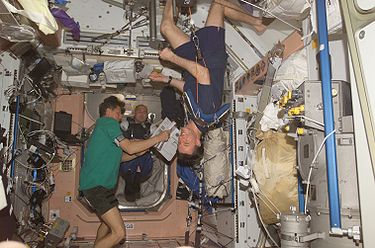
Physics
Weightlessness occurs whenever the total force applied to an object is uniformly distributed across the object's mass, or when the object is not acted upon by any force. The conceptually simplest case, apart from the latter, is that where there are no other forces than gravity, while the gravitational field is uniform. This is what approximately applies in the most common cases of approximate weightlessless. Other examples include various types of levitation, if the levitational force is uniformly distributed across the object's mass.
Weightlessness is in contrast with typical human experiences in which a non-uniform force is acting, such as:
- standing on the ground, sitting in a chair on the ground, etc., where gravity is countered by the reaction force of the ground,
- flying in a plane, where a reaction force is transmitted from the lift the wings provide (special trajectories which form an exception are described below),
- during atmospheric reentry, or during the use of a parachute, when atmospheric drag decelerates a vehicle,
- during an orbital maneuver in a spacecraft, or during the launch phase, when rocket engines provide thrust.
In cases where an object is not weightless, as in the above examples, a force acts non-uniformly on the object in question. Aero-dynamic lift, drag, and thrust are all non-uniform forces (they are applied at a point or surface, rather than acting on the entire mass of an object), and thus do not create the phenomenon of weightlessness. This non-uniform force may also be transmitted to an object at the point of contact with a second object, such as the contact between the surface of the Earth and one's feet, or between a parachute harness and one's body.
Gravity is a field force which may usually be considered to act uniformly on the mass of all objects in the frame of reference. This assumption is valid when the size of the region being considered is small relative to its distance from the center of mass of the gravitational counterpart. The small size of a person relative to the radius of Earth is one such example. In contrast, objects near a black hole are subject to a highly non-uniform gravitational field. These non-uniform fields near gravitating bodies produce local tidal forces inside human bodies and inside spacecraft. Near the Earth, they are responsible for the phenomenon of microgravity.
Terminology
Apparent weight
While the technical definition of weight is the size of the force of gravity acting on an object, humans experience their own body weight as a result of what is called apparent weight, or the normal force applied to a person by the surface on which the person is standing or sitting. In the absence of this reaction force, a person would be in free-fall, and would experience weightlessness. It is the transmission of this reaction force through the human body, and the resultant compression and tension of the body's tissues, that results in the sensation of weight.
Because of the distribution of mass throughout a person's body, the magnitude of the reaction force varies between a person's feet and head. At any horizontal cross-section of a person's body (as with any column), the size of the compressive force being resisted by the tissues below the cross-section is equal to the weight of the portion of the body above the cross-section. (In the arms, the reaction force is equal to the weight of the portion of the arm below the cross-section, and is a tensile, rather than a compressive, force, just as in a hanging rope.)
Several views of zero gravity
Sensitivity to forces
In Newton's view, astronauts in Earth orbit are in free fall, since they are in effect falling around the Earth. They are accelerated by gravity toward the Earth, but their inertia in the direction tangential with their path results in a curved path around the planet. In essence, they are always missing the planet in their fall toward it.
One way to view this situation, is to note that gravity by itself does not produce a weight-like force (a g-force) that people can directly sense, since gravity acts upon all parts of the body and the body only senses mechanical stresses (which to a good approximation, gravity does not produce, by itself). Thus, even a person standing on the Earth does not actually feel the pull of "gravity," but actually feels only the push of the ground, acting upward. If this push of the ground is suddenly removed (for example, in a free fall in an elevator), the person experiences weightlessness, because all the forces which have caused the sensation of "weight" have been removed, even though gravitational interactions continue.
Often, the terms zero gravity or reduced gravity are used to mean weightlessness as it is experienced by orbiting spacecraft. The idea of gravitation itself being greatly reduced in this situation is not technically accurate in the physics of Newton, although it is accurate in the physics of Einstein (general relativity).
Spacecrafts are held in orbit by the gravity of the planet which they are orbiting. In Newtonian physics, the sensation of weightlessness experienced by astronauts is not the result of there being zero gravitational acceleration (as seen from the Earth), but of there being no g-force that an astronaut can feel because of the free-fall condition, and also there being zero difference between the acceleration of the spacecraft and the acceleration of the astronaut. Space journalist James Oberg explains the phenomenon this way:[1]
The myth that satellites remain in orbit because they have "escaped Earth's gravity" is perpetuated further (and falsely) by almost universal misuse of the word "zero gravity" to describe the free-falling conditions aboard orbiting space vehicles. Of course, this isn't true; gravity still exists in space. It keeps satellites from flying straight off into interstellar emptiness. What's missing is "weight", the resistance of gravitational attraction by an anchored structure or a counterforce. Satellites stay in space because of their tremendous horizontal speed, which allows them — while being unavoidably pulled toward Earth by gravity — to fall "over the horizon." The ground's curved withdrawal along the Earth's round surface offsets the satellites' fall toward the ground. Speed, not position or lack of gravity, keeps satellites in orbit around the earth.
Relativity
To a modern physicist working with Einstein's general theory of relativity, the situation is even more complicated than is suggested above. Einstein's theory suggests that it actually is valid to consider that objects in inertial motion (such as falling in an elevator, or in a parabola in an airplane, or orbiting a planet) can indeed be considered to experience a local loss of the gravitational field responsible for their general motion. Thus, in the point of view (or frame) of the astronaut or orbiting ship, there actually is nearly-zero proper acceleration (the acceleration felt locally), just as would be the case far out in space, away from any mass. It is thus valid to consider that most of the gravitational field in such situations is actually absent from the point of view of the falling observer, just as the colloquial view suggests (see equivalence principle for a fuller explanation of this point). However, this loss of gravity for the falling or orbiting observer, in Einstein's theory, is due to the falling motion itself, and (again as in Newton's theory) not due to increased distance from the Earth. However, the gravity nevertheless is considered to be absent. In fact, Einstein's realization that a pure gravitational interaction cannot be felt, if all other forces are removed, was the key insight to leading him to the view that the gravitational "force" can in some ways be viewed as non-existent. Rather, objects tend to follow geodesic paths in curved space-time, and this is "explained" as a force, by "Newtonian" observers who assume that space-time is "flat," and thus do not have a reason for curved paths (i.e., the "falling motion" of an object near a gravitational source).
In the theory of general relativity, the only gravity which remains for the observer following a falling path or "inertial" path near a gravitating body, is that which is due to non-uniformities which remain in the gravitational field, even for the falling observer. This non-uniformity, which is a simple tidal effect in Newtonian dynamics, constitutes the "microgravity" which is felt by all spacially-extended objects falling in any natural gravitational field that originates from a compact mass. The reason for these tidal effects is that such a field will have its origin in a centralized place (the compact mass), and thus will diverge, and vary slightly in strength, according to distance from the mass. It will thus vary across the width of the falling or orbiting object. Thus, the term "microgravity," an overly technical term from the Newtonian view, is a valid and descriptive term in the general relativistic (Einsteinian) view.
Microgravity
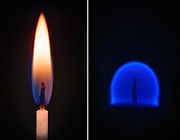
The term micro-g environment (also µg, often referred to by the term microgravity) is more or less a synonym of weightlessness and zero-G, but indicates that g-forces are not quite zero, just very small.[citation needed]
Weightless and reduced weight environments

Reduced weight in aircraft
Airplanes have been used since 1959 to provide a nearly weightless environment in which to train astronauts, conduct research, and film motion pictures. Such aircraft are commonly referred by the nickname "Vomit Comet".
To create a weightless environment, the airplane flies in a six-mile long parabolic arc, first climbing, then entering a powered dive. During the arc, the propulsion and steering of the aircraft are controlled such that the drag (air resistance) on the plane is canceled out, leaving the plane to behave as it would if it were free-falling in a vacuum. During this period, the plane's occupants experience about 25 seconds of weightlessness, before experiencing about 25 seconds of 2 g acceleration (twice their normal weight) during the pull-out from the parabola. A typical flight lasts around two hours, during which 50 parabolas are flown.

NASA's Reduced Gravity Aircraft
Versions of such airplanes have been operated by NASA's Reduced Gravity Research Program since 1973, where the unofficial nickname originated.[2] NASA later adopted the official nickname 'Weightless Wonder' for publication.[3] NASA's current Reduced Gravity Aircraft, "Weightless Wonder VI", a McDonnell Douglas C-9, is based at Ellington Field (KEFD), near Lyndon B. Johnson Space Center.
NASA's Microgravity University - Reduced Gravity Flight Opportunities Plan, also known as the Reduced Gravity Student Flight Opportunities Program, allows teams of undergraduates to submit a microgravity experiment proposal. If selected, the teams design and implement their experiment, and students are invited to fly on NASA's Vomit Comet.
European Space Agency A300 Zero-G
The European Space Agency flies parabolic flights on a specially-modified Airbus A300 aircraft, in order to research microgravity. The ESA flies campaigns of three flights on consecutive days, each flight flying about 30 parabolas, for a total of about 10 minutes of weightlessness per flight. The ESA campaigns are currently operated from Bordeaux - Mérignac Airport in France by the company Novespace,[4] while the aircraft is operated by the Centre d'essais en Vol (CEV - French Test Flight Centre). The first ESA Zero-G flights were in 1984, using a NASA KC-135 aircraft in Houston, Texas. As of March 2006[update], the ESA has flown 43 campaigns. Other aircraft it has used include the Russian Ilyushin Il-76 MDK and French Caravelle.[5][6][7]
Ecuadorian T-39 Condor
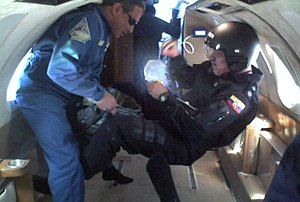
The Ecuadorian Space Agency jointly operates, with the Ecuadorian Air Force, the Ecuadorian Micro Gravity Flight Program, using a T-39 Sabreliner, modified in-house to fly "cybernetically assisted" parabolas. It has been in operation since May 2008. It is the first Latin American microgravity aircraft.[8] On June 19, 2008, the plane carried seven-year-old Jules Nader as he set the first Guinness World record for the youngest human being to fly in microgravity. Nader worked on a fluid dynamics experiment designed by his brother, Gerard Nader.[9]
Others
The Zero Gravity Corporation, founded in 1993 by Peter Diamandis, Byron Lichtenberg, and Ray Cronise, operates a modified Boeing 727 which flies parabolic arcs like those of NASA's Reduced Gravity Aircraft. Flights may be purchased for both tourism and research purposes.
Reduced weight in pilot training
People have differing reactions to reduced weight sensations, and these reactions can compromise flight safety if an aircraft pilot is not trained to respond properly, particularly in an emergency. Normally in flight training, flight instructors will gradually introduce reduced weight maneuvers, while carefully monitoring the student pilot. Most students become accustomed to the sensation and are able to perform satisfactorily with some training. Students who are not able to overcome their anxiety are not able to complete flight training.[10]
Ground-based drop facilities
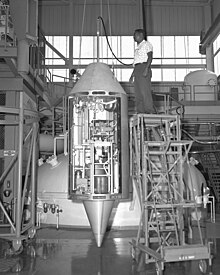
Ground-based facilities that produce weightless conditions for research purposes are typically referred to as drop tubes or drop towers.
NASA's Zero Gravity Research Facility, located at the Glenn Research Center in Cleveland, Ohio, is a 145-meter vertical shaft, largely below the ground, with an integral vacuum drop chamber, in which an experiment vehicle can have a free fall for a duration of 5.18 seconds, falling a distance of 132 meters. The experiment vehicle is stopped in approximately 4.5 meters of pellets of expanded polystyrene and experiences a peak deceleration rate of 65g.
Also at NASA Glenn is the 2.2 Second Drop Tower, which has a drop distance of 24.1 meters. Experiments are dropped in a drag shield, in order to reduce the effects of air drag. The entire package is stopped in a 3.3 meter tall air bag, at a peak deceleration rate of approximately 20g. While the Zero Gravity Facility conducts one or two drops per day, the 2.2 Second Drop Tower can conduct up to twelve drops per day.
NASA's Marshall Space Flight Center hosts another drop tube facility that is 105 meters tall and provides a 4.6 second free fall under near-vacuum conditions.[11]
Humans cannot utilize these gravity shafts, as the deceleration experienced by the drop chamber would likely kill or seriously injure anyone using them; 20g is about the highest deceleration that a fit and healthy human can withstand momentarily without sustaining injury.[citation needed]
Other drop facilities worldwide include:
- Micro-Gravity Laboratory of Japan (MGLAB) – 4.5 s free fall
- Experimental drop tube of the metallurgy department of Grenoble – 3.1 s free fall
- Fallturm Bremen University of Bremen in Bremen – 4.74 s free fall
- Queensland University of Technology Drop Tower - 2.0 s free fall
Neutral buoyancy
Weightlessness can also be simulated by creating the condition of neutral buoyancy, in which human subjects and equipment are placed in a water environment and weighted or buoyed until they hover in place. NASA uses neutral buoyancy to prepare for extra-vehicular activity (EVA) at its Neutral Buoyancy Laboratory. Neutral buoyancy is also used for EVA research at the University of Maryland's Space Systems Laboratory, which operates the only neutral buoyancy tank at a college or university.
Neutral buoyancy is not identical to weightlessness. Gravity still acts on all objects in a neutral buoyancy tank; thus, astronauts in neutral buoyancy training still feel their full body weight within their spacesuits, although the weight is well-distributed, similar to force on a human body in a water bed, or when simply floating in water. The suit and astronaut together are under no net force, as for any object that is floating, or supported in water, such as a scuba diver at neutral buoyancy. Water also produces drag, which is not present in vacuum.
Weightlessness in a spacecraft

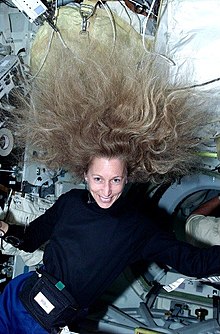
Long periods of weightlessness occur on spacecraft outside a planet's atmosphere, provided no propulsion is applied and the vehicle is not rotating. Weightlessness does not occur when a spacecraft is firing its engines or when re-entering the atmosphere, even if the resultant acceleration is constant. The thrust provided by the engines acts at the surface of the rocket nozzle rather than acting uniformly on the spacecraft, and is transmitted through the structure of the spacecraft via compressive and tensile forces to the objects or people inside.
Weightlessness in an orbiting spacecraft is physically identical to free-fall, with the difference that gravitational acceleration causes a net change in the direction, rather than the magnitude, of the spacecraft's velocity. This is because the acceleration vector is perpendicular to the velocity vector.
In typical free-fall, the acceleration of gravity acts along the direction of an object's velocity, linearly increasing its speed as it falls toward the Earth, or slowing it down if it is moving away from the Earth. In the case of an orbiting spacecraft, which has a velocity vector largely perpendicular to the force of gravity, gravitational acceleration does not produce a net change in the object's speed, but instead acts centripetally, to constantly "turn" the spacecraft's velocity as it moves around the Earth. Because the acceleration vector turns along with the velocity vector, they remain perpendicular to each other. Without this change in the direction of its velocity vector, the spacecraft would move in a straight line, leaving the Earth altogether.
Weightlessness at the center of a planet
The net gravitational force due to a spherically symmetrical planet is zero at the center. This is clear because of symmetry, and also from Newton's shell theorem which states that the net gravitational force due to a spherically symmetric shell, e.g., a hollow ball, is zero anywhere inside the hollow space. Thus the material at the center is weightless.
Human health effects

Following the advent of space stations that can be inhabited for long periods of time, exposure to weightlessness has been demonstrated to have some deleterious effects on human health. Humans are well-adapted to the physical conditions at the surface of the Earth. In response to an extended period of weightlessness, various physiological systems begin to change and atrophy. Though these changes are usually temporary, long term health issues can result.
The most common problem experienced by humans in the initial hours of weightlessness is known as space adaptation syndrome or SAS, commonly referred to as space sickness. Symptoms of SAS include nausea and vomiting, vertigo, headaches, lethargy, and overall malaise. The first case of SAS was reported by cosmonaut Gherman Titov in 1961. Since then, roughly 45% of all people who have flown in space have suffered from this condition. The duration of space sickness varies, but in no case has it lasted for more than 72 hours, after which the body adjusts to the new environment. NASA jokingly measures SAS using the "Garn scale", named for United States Senator Jake Garn, whose SAS during STS-51-D was the worst on record. Accordingly, one "Garn" is equivalent to the most severe possible case of SAS.[12]
The most significant adverse effects of long-term weightlessness are muscle atrophy and deterioration of the skeleton, or spaceflight osteopenia. These effects can be minimized through a regimen of exercise. Astronauts subject to long periods of weightlessness wear pants with elastic bands attached between waistband and cuffs to compress the leg bones and reduce osteopenia.[13] Other significant effects include fluid redistribution (causing the "moon-face" appearance typical of pictures of astronauts in weightlessness),[13][14] a slowing of the cardiovascular system, decreased production of red blood cells, balance disorders, and a weakening of the immune system. Lesser symptoms include loss of body mass, nasal congestion, sleep disturbance, excess flatulence, and puffiness of the face. These effects begin to reverse quickly upon return to the Earth.
Many of the conditions caused by exposure to weightlessness are similar to those resulting from aging. Scientists believe[who?] that studies of the detrimental effects of weightlessness could have medical benefits, such as a possible treatment for osteoporosis and improved medical care for the bed-ridden and elderly.
Effects on non-human organisms
Russian scientists have observed differences between cockroaches conceived in space and their terrestrial counterparts. The space-conceived cockroaches grew more quickly, and also grew up to be faster and tougher.[15]
Fowl eggs which are fertilized in microgravity may not develop properly.[16]
Technical adaptation in zero-gravity
Weightlessness can cause serious problems on technical instruments, especially those consisting of many mobile parts. Physical processes that depend on the weight of a body (like convection, cooking water or burning candles) act differently without a certain amount of gravity. Cohesion and advection play a bigger role in space. Everyday work like washing or going to the bathroom are not possible without adaptation. To use toilets in space, like the one on the International Space Station, astronauts have to fasten themselves to the seat. A fan creates suction that carries the waste away. Drinking is aided with a straw or from tubes.
See also
References
- ^ Oberg, James (1993). "Space myths and misconceptions". Omni. 15 (7). Retrieved 2007-05-02.
{{cite journal}}: Unknown parameter|month=ignored (help) - ^ Reduced Gravity Research Program
- ^ NASA "Weightless Wonder"
- ^ Novespace: microgravity, airborne missions
- ^ European Space Agency. "A300 Zero-G". ESA Human Spaceflight web site. Retrieved 2006-11-12.
- ^ European Space Agency. "Next camaign". ESA Human Spaceflight web site. Retrieved 2006-11-12.
- ^ European Space Agency. "Campaign Organisation". ESA Human Spaceflight web site. Retrieved 2006-11-12.
- ^ EXA and FAE Develops First Zero-G Plane in Latin America
- ^ Youngest person to experience microgravity
- ^ Reduced G Familiarization from Gliding New Zealand.
- ^ Marshall Space Flight Center Drop Tube Facility
- ^ http://www.jsc.nasa.gov/history/oral_histories/StevensonRE/RES_5-13-99.pdf, pg 35, Johnson Space Center Oral History Project, interview with Dr. Robert Stevenson:
"Jake Garn was sick, was pretty sick. I don't know whether we should tell stories like that. But anyway, Jake Garn, he has made a mark in the Astronaut Corps because he represents the maximum level of space sickness that anyone can ever attain, and so the mark of being totally sick and totally incompetent is one Garn. Most guys will get maybe to a tenth Garn, if that high. And within the Astronaut Corps, he forever will be remembered by that."
- ^ a b "Health Fitness", Space Future
- ^ "The Pleasure of Spaceflight", Toyohiro Akiyama, Journal of Space Technology and Science, Vol.9 No.1 spring 1993, pp.21-23
- ^ "Mutant super-cockroaches from space". New Scientist. January 21, 2008.
{{cite web}}: Cite has empty unknown parameter:|coauthors=(help) - ^ "Egg Experiment in Space Prompts Questions". New York Times. 1989-03-31.
External links
- Microgravity Centre
- Criticism of the terms "Zero Gravity" and "Microgravity"
- Microgravity flights on board the Airbus A300 Zero-G
- maniacworld.com "NASA Reduced Gravity Aircraft", videos of the NASA Reduced Gravity Aircraft and of participants in a flight on that aircraft.
- How Weightlessness Works at HowStuffWorks
